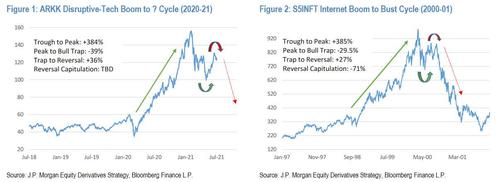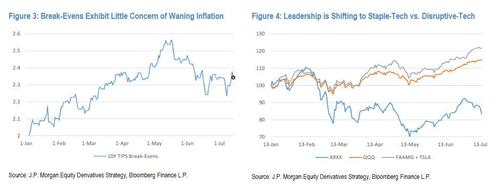JPMorgan Goes After Cathie Wood, Urges Buying Puts On Her “Bubble-Like” Ark Fund
Until now, JPMorgan’s feud was mostly with bitcoin, publishing hitpiece after hitpiece with Swiss watch regularity every other day (as it quietly accumulates the cryptocurrency for its own recently launched fund for rich clients). But now, the largest US bank, which has been furiously clinging to its favorite reco of buying cyclical and value names at the expense of growth stocks – a trade which has backfired painfully in recent weeks – is escalating its crusade against tech by going after the poster child, or rather poster woman, of the latest tech bubble, Cathie Wood.
In a note from JPM published this morning, equity derivative strategist Shawn Quigg says that Cathie Wood’s flagship ETF, ARKK, is exhibiting many “bubble-like traits” seen in growth-based funds in 2000 ahead of the popping of the dot com bubble, and investors should hedge against a similar outcome by buying puts on the Ark Fund.
Taking precious time away from its favorite bitcoin bashing pastime, JPMorgan – which we doubt is Cathie’s Prime Broker – writes that “excessive speculation in high-growth sub-sectors year-to-date is causing some growth-based funds to exhibit bubble-like cycles (Fig. 1), similar to that witnessed in 2000 (Fig. 2). The ARK Innovation ETF exhibits many of these traits, and may be luring investors into a bull trap scenario.”
JPM’s beef with Cathie aside, what we find most remarkable in Quigg’s note is that this is the first time the largest US bank has gone on the record to admit that “significant fiscal and monetary stimulus” has led to “bubble-like” activity similar to that witnessed in 2000. Here is how Quigg lays out his thesis on “navigating a bubble” which culminates by shorting ARKK:
- Eexcessive speculation in high-growth stocks and sub-sectors year-to-date, aided by significant fiscal and monetary stimulus, and ample liquidity in corporate and consumer balance sheets, is causing some growth-based funds to exhibit bubble-like cycles, similar to that witnessed in 2000 (Fig. 2).
- The ARKK 2020-21 trough to peak run of 385% fits the criteria we previously described as a bubble, a direct beneficiary of the Electric Vehicle/Green Tech (e.g., TSLA), Cryptocurrency (e.g., COIN, SQ), Work-From-Home (e.g., TDOC, ROKU, ZM), and pandemic biotech (e.g., CRSP) stocks/sub-sectors.
- However, after peaking in February, ARKK shares broke below key technical supports (e.g., 50, 100, 200-day moving averages)in just a matter of months (May) as the retail/Reddit mania, work from home and cryptocurrency trades (among others) faltered.
- A technical decline in Treasury yields and fear of the Delta variant allowed for a rebound in high-tech growth, and ARKK.
Combining these four catalysts is how the “bull trap” was set according to JPM.
But sticking to the bank’s party line which “favors the outperformance of cyclicals/value-based assets amid the ongoing economic reopening, and an anticipated pick-up in Treasury yields in 2H” the bank says that investors should now start to exit said “bull trap” as the imminent “rise in yields and a shift in the growth dynamic of the economy in-line with our value-based view could spark a bull trap reversal in ARKK shares.”
What specific event will spark the “capitulation” in ARKK shares? The same reflationary jump in bond yields that Marko Kolanovic has been predicting for months and months – even as yields tumbled – to wit:
As we note, we believe the recent move in Treasury yields is technical in nature and is not an indication of a broader investor concern surrounding the health of the recovery, or a waning inflation outlook. Supporting this is the lack of tapering in the 10Y TIPS break-evens (Fig. 3), continued inflation reading above expectations (e.g., CPI, PPI, management commentary), and a recent weaker-than-anticipated 30Y Treasury auction (here).
A looming rise in yields could be a catalyst to accelerate ARKK shares lower, in addition to the continued outperformance of large staple-tech stocks over disruptive-tech stocks (Fig. 4),and pressing ARKK into the capitulation phase.
JPM is, of course, correct: if a rise in yields is indeed “looming”, then not just ARKK but all high duration names will be clobbered, starting with the FAAMGs, a move which would then translate into a marketwide rout (oddly enough we don’t see JPMorgan cutting their year-end S&P forecast). The question is if and when yields will again spike higher, and what would spark this move in a world where the Fed is now supposedly “on top of inflation fears” and won’t let rates rise too much, especially as growth fears over the spreading Delta variant dominate trading discussions.
Assuming readers agree with the JPM strategist that another spike in yields is imminent, how should they play the coming weakness in ARKK? As Quigg explains, “current 3M 90% implied volatility of ~39% appears cheap, ranking in its 14th%-ile over thelast year. Given ARKK has a limited history, with the bulk of its returns and volatility occurring over the last year, we find utilizing the last year as a fair comparable measure, particularly if the stock may be poised for a broader capitulation phase.”
As a result, JPMorgan recommends “investors purchase ARKK October 105 strike puts for $4.50, indicatively ($118.17 reference price), taking advantage of implied volatility near a yearly low despite the potential for shares to enter a broader capitulation phase.”
Tyler Durden
Thu, 07/15/2021 – 11:26![]()
Zero Hedge’s mission is to widen the scope of financial, economic and political information available to the professional investing public, to skeptically examine and, where necessary, attack the flaccid institution that financial journalism has become, to liberate oppressed knowledge, to provide analysis uninhibited by political constraint and to facilitate information’s unending quest for freedom. Visit https://www.zerohedge.com

